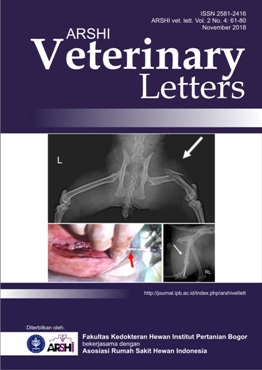Infeksi Heterodoxus spiniger pada Canis lupus familiaris
Abstract
Seekor anjing domestik (Canis lupus familiaris) liar didiagnosa terinfeksi kutu pengunyah Heterodoxus spiniger di Klinik hewan My Vets Bumi Serpong Damai. Heterodoxus spiniger merupakan kutu pengunyah yang menginfeksi anjing domestik (Canis lupus familiaris), ras anjing lain, dan hewan marsupialia. Kutu ini juga merupakan inang antara dari cacing pita Dipylidium caninum dan filaria cacing gilig Dipetalonema reconditum. Studi kasus ini akan membahas tentang tata cara pendiagnosaan dan penanganan terhadap infeksi Heterodoxus spiniger pada Canis lupus familiaris. Diagnosa dilakukan melalui pemeriksaan fisik dan penegakan diagnosa dengan pemeriksaan mikroskopis teknik trichogram pada contoh kutu. Pengobatan terhadap kutu ini dilakukan menggunakan kombinasi flumethryn dan ivermectin efektif hingga 7 hari.Downloads
References
Agarwal GP, Chandra S, Saxena AK. 1982. Feeding habits of dog louse Heterodoxus spiniger (End.)(Mallophaga, Amblycera). Zeitschrift für Angewandte Entomologie, 94(1‐5): 134-137.
Currie BJ, McCarthy JS. 2010. Permethrin and ivermectin for scabies. New England Journal of Medicine, 362(8): 717-725.
Roberts L, Janovy J. 2000. Foundation of parasitology, 5th. WCB Company, UK, 347-410.
Shanks DJ, Gautier P, McTier TL, Evans NA, Pengo G, Rowan TG. 2003. Efficacy of selamectin against biting lice on dogs and cats. Veterinary Record, 152(8): 234-237
Copyright (c) 2018 CC-BY-SA

This work is licensed under a Creative Commons Attribution-ShareAlike 4.0 International License.
Authors who publish with this journal agree to the following terms:
1. Authors retain copyright and grant the journal right of first publication with the work simultaneously licensed under a Creative Commons Attribution License that allows others to share the work with an acknowledgement of the work's authorship and initial publication in this journal.
2. Authors are able to enter into separate, additional contractual arrangements for the non-exclusive distribution of the journal's published version of the work (e.g., post it to an institutional repository or publish it in a book), with an acknowledgement of its initial publication in this journal.
3. Authors are permitted and encouraged to post their work online (e.g., in institutional repositories or on their website) prior to and during the submission process, as it can lead to productive exchanges, as well as earlier and greater citation of published work (See The Effect of Open Access).


.jpg)















